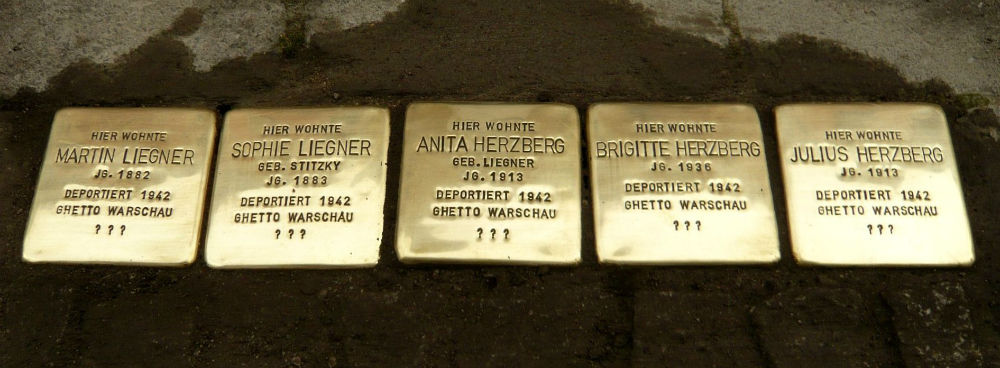Stumbling Stones Kochstraße 11
These Stolpersteine / Stumbling Stones commemorate:
* Martin Liegner, born 1882, deported 1942 to Warsaw Ghetto, ??? [fate unknown]
* Sophie Liegner née Stitzky, born 1883, deported 1942 to Warsaw Ghetto, ???
* Anita Herzberg née Liegner, born 1913, deported 1942 to Warsaw Ghetto, ???
* Brigitte Herzberg, born 1936, deported 1942 to Warsaw Ghetto, ???
* Julius Herzberg, born 1913, deported 1942 to Warsaw Ghetto, ???
Martin Liegner, a businessman and Sophie Liegner née Stitzky were married. Their daughter Anita was born in 1913. Six years later he opened a cleaning company, which provided the family’s financial security for almost 20 years. Anita married Julius Herzberg, a gardener and they had a daughter, Brigitte. On 12 November 1938 came the order to eliminate Jews from German economic life. After that, Martin worked in a lumberyard. The family was next forced to move into a "Judenhaus." Then, on 30 March 1942, Martin had to sign away his assets – a step required of all Jews destined for deportation.
When they all were deported the next month to the Warsaw Ghetto, Martin and Sophie Liegner were ages 60 and 59, Anita and Julius Herzberg were 29 and Brigitte was only 6.
Their fates are unknown but can be guessed from the story of the Warsaw Ghetto. The Jewish population of Warsaw before the war was 375,000 – 30% of the city’s residents. In November 1940, Germans established the Warsaw Ghetto, forced all Jews to move there (an area that was just 2.4% of the city). The ghetto was sealed off with 3-meter walls and guards to prevent movement between the ghetto and the rest of the city. Deportations from outside Warsaw increased the population, which reached approximately 400,000, with an average of 7.2 persons per room. Food was inadequate for survival. Between 1940 and mid-1942, 83,000 Jews died of starvation and disease. The Polish resistance fighter Jan Karski describes the conditions that he himself experienced: "There was nothing human about these shaking figures except skin, eyes and voice. There was hunger and misery everywhere; it reeked horribly of decaying corpses; you heard the miserable whimpering of dying children and the desperate cries and gasps of a people in the hopeless struggle for survival."
Further, from July - September 1942, Germans deported an estimated 265,000 Jews to the Treblinka death camp and murdered another 35,000 inside the ghetto.
Martin’s younger brother, Hermann Liegner, was also deported from Cottbus to the Warsaw Ghetto in April 1942. His stolperstein is at Rudolf-Breitscheid-Straße 5 in Cottbus.
"Stolpersteine" is an art project for Europe by Gunter Demnig to commemorate victims of National Socialism (Nazism). Stolpersteine (stumbling stones) are small, 10x10cm brass plaques placed in the pavement in front of the last voluntary residence of (mostly Jewish) victims who were murdered by the Nazis. Each plaque is engraved with the victim’s name, date of birth and place (mostly a concentration camp) and date of death. By doing this, Gunter Demnig gives an individual memorial to each victim. One stone, one name, one person. He cites the Talmud: "A human being is forgotten only when his or her name is forgotten."
Do you have more information about this location? Inform us!
Source
Nearby
Point of interest
Monument
- Soviet War Memorial Cottbus - Cottbus
- War Memorial Kiekenbusch - Kiekenbusch (Cottbus)
- War Memorial Leuthen - Leuthen
Cemetery
- Mass Grave Polish Forced Laborers - Cottbus
- German War Graves Cottbus - Cottbus
- Soviet War Graves Cottbus - Cottbus





